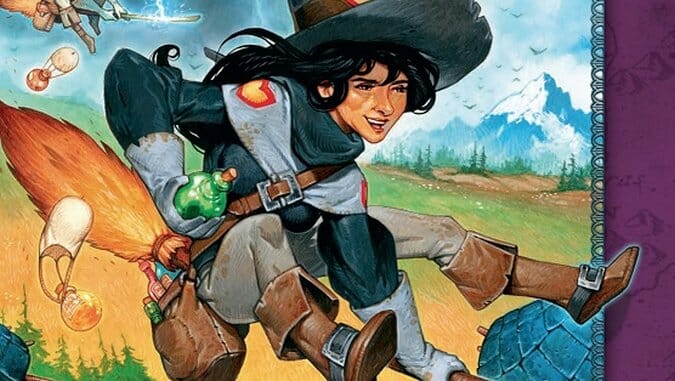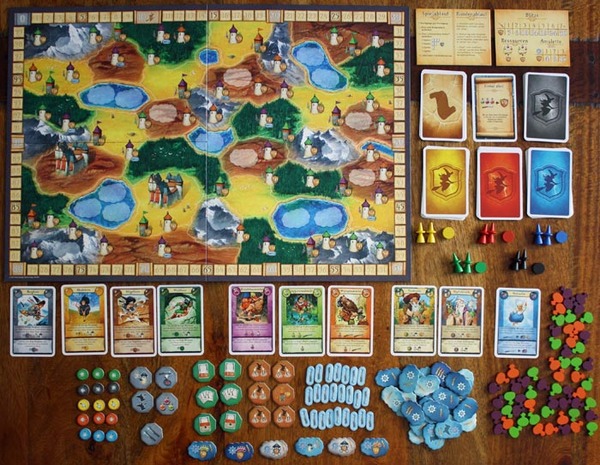
Broom Service won this year’s Kennerspiel des Jahres, the award given to the connoisseur’s game of the year by the panel of German game critics responsible for the Spiel des Jahres (game of the year) award that has become the most commercially important prize in boardgaming. Last year’s Kennerspiel des Jahres award went to Istanbul, and this year’s list of nominees also included Elysium and Orleans. Broom Service is on the lighter side for the Kennerspiel award, but that also makes it more accessible than most nominees, and the theme—witches using fairies and druids to deliver potions to castle towers—and graphics make it visually appealing to just about everyone.
Broom Service combines a few familiar mechanics into a new overarching structure with one twist I haven’t seen before. It’s a game of role selection and movement on a map, adding a bluffing element to role selection. Each player begins the game with a set of ten cards representing different roles: three merchants to gain potions and/or wands; four fairies for delivering potions; two druids for delivering potions in another fashion; and one weather fairy for chasing away clouds for bonus points. The game comprises seven rounds, and in each round each player chooses four roles from his/her hand without showing them to other players. That’s when the bluffing starts.
Each role card has two functions on it. The “cowardly” function lets the player do something small without any interference from another player, but it’s typically not that useful. The “brave” function adds the useful bit; for example, a cowardly Forest Fairy lets you move one of your two witch tokens to an adjacent forest space, but a brave Forest Fairy lets you also deliver a potion to a tower on or abutting that forest. The catch is that only one person per round can be brave for a particular role. If you choose to play the Forest Fairy and say (aloud) that you’re a brave one, then any other player who chose that role can play it, choose the brave option, and prevent you from using any of the card’s functions at all. Subsequent players can also steal this role; all players get a crack at it, and must play the card if they’re holding it, although any player can choose to be cowardly even if the brave option is already on the table. Games with fewer than five players also include “bewitched” roles that change each round and carry a three-point penalty if they’re chosen.
Players score points in two primary ways: Delivering potions and collecting clouds. There are three colors of potions—green, orange, and purple—and there are towers in all three colors scattered across the map, some wholly ensconced within specific spaces, others sitting on roads or junctions that abut two or more spaces. To deliver a position, you must play a brave fairy that matches the area type for that tower and then have a potion of the correct color to deliver, or you must play a druid (cowardly works; brave just gets you three more points) of the area type on which your witch already sits and deliver a potion of the correct color. Some towers can only accept one delivery per game, while others will take all you can give. Each tower has a specific bonus attached to it for delivery of a potion, and the further on the map you get from the start space, the higher the bonuses get.
There are clouds scattered across the board as well, and you can use the weather fairy to collect them, gaining three bonus points if you’re a brave weather fairy. You collect wands and spend the number shown on the cloud token to gather it; at game-end, you receive a bonus based on the total number of lightning bolts shown on the clouds you’ve garnered over the course of the entire game. No witch can enter any space with a cloud on it, so clearing clouds can help you but also may help your opponents.
Each round has a specific bonus drawn from a separate deck of cards that’s shuffled each game, with bonuses ranging from points gained or lost based on where your witch tokens ended the round or points added in exchange for what goods (potions and wands) you have on hand. While these help, they’re relatively small compared to the points you gain from potion delivery, so they’re not likely to alter anyone’s strategy. There are also a number of optional tiles and more involved cloud tokens that add further bonuses if you’d like to play a slightly more advanced variant, although there’s a bit of unneeded complexity in their inclusion.
At heart, this is a game of bluffing and of a form of trading goods—it’s delivery with a twist. The core concepts themselves are quite simple, although my nine-year-old daughter (and unofficial game tester) took a few games to figure out the bluffing aspect of choosing a role. The artwork is cartoonish, but bright and fun and, unlike a lot of sophisticated boardgames, doesn’t seem to appeal specifically to either gender. It’s a worthy nominee for the Kennerspiel des Jahres, with enough room for strategy to qualify for this higher-level award but the accessibility of somewhat lighter games like Small World (whose map this board resembles) or Splendor.
Keith Law is a senior baseball writer for ESPN.com and an analyst on ESPN’s Baseball Tonight. You can read his baseball content at search.espn.go.com/keith-law and his personal blog the dish, covering games, literature, and more, at meadowparty.com/blog.
